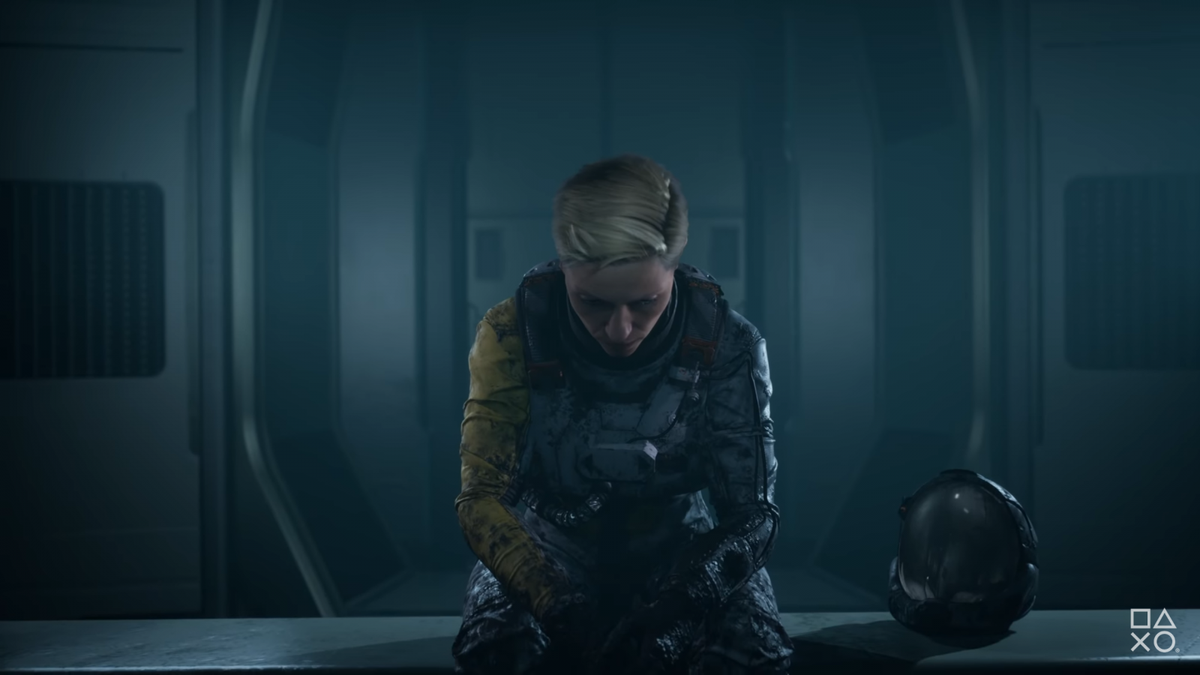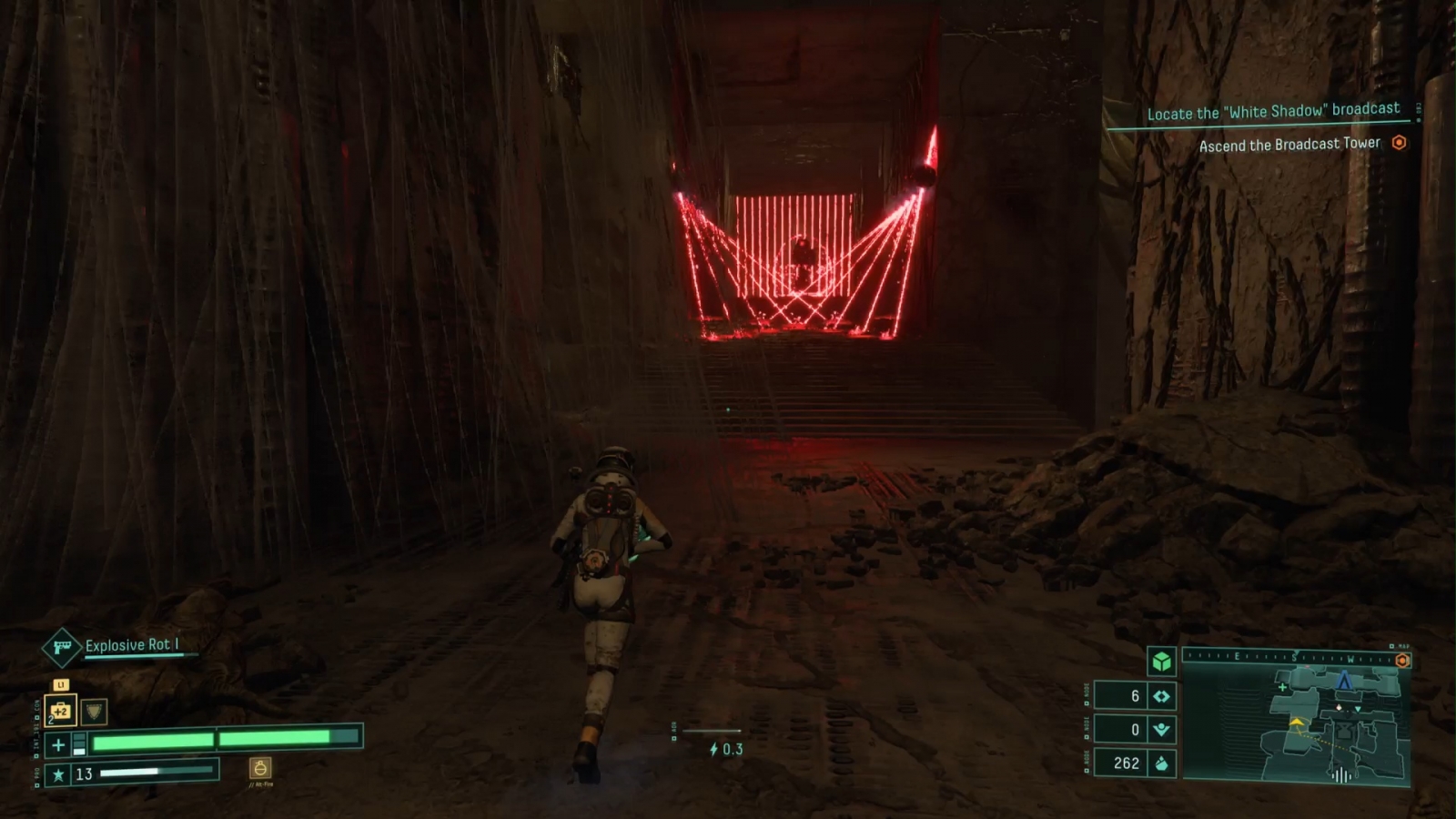
It’s really hard to make something unique in the gaming world today. Most genres have been explored, and while we sometimes get new takes (games like PUBG and The Binding of Isaac come to mind), for the most part we see familiar ideas based around what we already know. For every Call Of Duty there’s a Battlefield, for every Gran Turismo there’s a Forza Motorsports. That’s not to say they can’t be good, and the aforementioned games have done a great job of perfecting their genres, but fresh takes can be few and far between. Every once in a while, however, we come to something like Returnal, the latest game from Housemarque, which has taken several different genres and ideas and mashed them together to create something that feels so familiar, but still manages to find a way to be unique and satisfying.
Let’s start right at the beginning shall we? You play as Selene, a space scout sent to investigate a mysterious signal on the planet Atropos. During your descent, something goes terribly wrong as your engine is hit by a lightning strike and you crash land on the planet below. What follows is truly disturbing as while searching for this signal you come upon a dead body. That may not seem so bad, but upon further investigation you find out it’s… you. Not only that, when you die you don’t really die, you return to that crash, just without all the stuff you collected along the way. Now, let me set this straight, as much as parts of the narrative may look and seem like horror, Returnal falls more into the thriller category. There are moments, like the first person jaunts through your house that has somehow made its way to an alien planet that are quite unnerving, but I haven’t come across anything that could even qualify as a jump scare.
That’s not to say the atmosphere isn’t creepy, it just doesn’t fall into scary. What Returnal does manage to accomplish however is a general feeling of uneasiness. What’s around the next corner? What creatures may be waiting to tear my head off in the next area? Given Selene is just a puny human, especially at the start, the way Returnal takes the roguelike formula and adds in eerie space vibes (that background music tho) instantly establishes the tone.
Speaking of roguelikes, many may find Returnal a bit difficult, at least at the beginning. This game is following the genre to a tee, if you die you go back to the opening area (a great way to mesh the genre with the narrative), with very little to show for the time you invested into your run. This is par for the course, but some will find Returnal’s arduous nature to be a product of just being hard rather than the type of game it is. I prefer to look at it this way: Returnal has a steep learning curve like a Dark Souls game.
Here’s why I can make that claim. I played for about four or so hours in the first biome, just trying to brute force my way through the boss but to no avail. Upon taking the time to learn the systems in play, the weapons, the upgrades, doing all the side things I could, I managed to finally take that first boss, a grotesque beast named Phrike, down. Was it an intense fight? Absolutely, and bosses in games should be that way. But were my first few hours with Returnal overwhelmingly difficult due to design? Nope, it was simply my inexperience with playing a roguelike. Humble brag, I actually took out the second boss, Ixion, in one go because I understood the mechanics much more at that point. Returnal is tough, no doubt, but taking the time to learn how to play it lessens the blow immensely.
That being said, one of the reasons I kept on going despite sucking horribly at Returnal at the beginning is because of the impressively strong gameplay loop. We have a lot to talk about when it comes to weaponry, upgrades, and the like, but to sum up the basic gameplay, it works in an extremely fluid manner. Many reviews are probably going to bring up Control as a comparison (and many previews already have), and rightly so. All of Selene’s movements are crisp; dashing, running, and jumping her way around each area very deftly. This makes its way into the gunplay as well, with every shot feeling precise and functioning as it should. It’s tough to describe just how much of a joy it is to play Returnal from a sheer gameplay standpoint, but even if this game was only “shoot bugs, move to the next location” I’d be fine with that.
Part of that is due to the astounding manner in which Housemarque has adapted something they know so well into a third-person action game. For those who don’t know it, Housemarque is most well known for its bullet-hell top down shooters, and somehow they manage to meld this into Returnals core. When you fight enemies, huge rows of projectiles spew from them, causing you to have to dart around the battlefield while assaulting these foes. The emphasis on making these “hurt balls” colorful makes them easy enough to plan your movement, and it makes for plenty of fireworks on the screen. Taking on the bosses however are where it all ramps up, as it will seem like billions of these are hunting you down, and the sheer spectacle of it all makes for some of the best boss fighting I’ve had in a long time.
I want to call attention to the third boss fight in particular, which is a phenomenal feat of level crafting. If you couldn’t tell, I’m a sucker for good boss fights, and Returnal has plenty of those. Just like a Souls title, these bosses give you that dopamine rush when you finish them off, and that speaks to a well-designed game.
This had to be challenging for Housemarque to build given they have no history making this kind of game, but the talent involved in crafting these levels is bewildering. True, this isn’t a huge open world like Horizon Zero Dawn, and the set pieces can blend together in places, but the procedural way in which the areas arrange themselves with each new playthrough is awesome. I have yet to encounter the same layout in a run again, with the exception of restarting my game in order to stream the first levels. This works well with how much there is to do in each biome, and players are going to find plenty of side things to keep them busy. I didn’t even touch them before, but there are triangular doors on the mini-map (which itself is incredibly detailed) which will indicate a side path. Take them, you’ll almost always find something worth it, and it’s a good way to grind up to take on your next opponent.
The design of the game does lean well into what roguelike genres tend to gravitate towards with procedural levels like Dead Cells, and you’ll also have plenty of things to lose when you make a wrong move. Just like any roguelike game, death resets you, with the exception of a few things. With Returnal, you’re going to keep any major story items like the melee “katana”, as well as Ether (which is an important resource to spend). Beyond that you are largely back to square one, with health, weaponry, artifacts, and upgrades all lost. There are ways to cheat the cycle, but those are ones you’ll have to find out on your own, and they are just temporary. Roguelikes don’t like to make it easy on you, every extra chance you find will cost you and there aren’t many available.
What is available on your runs is surprisingly in depth, with plenty of systems and upgrades to learn as you go on your way. I do suggest taking your time here, as my doing so would’ve saved me a lot of annoyance in the early hours of the game. Your weapons are pretty standard, with pistols, rifles, launchers, and shotguns that will keep hostiles at bay, but it’s best to think carefully about what you’re using. Sometimes a level 9 rifle will work out better than a level 10 shotgun because your health is low and you need to keep a distance. While not every area will let you in without locking down, I’ve walked in and ran back out because I knew a certain creature was about to spawn and I’d left a more suitable weapon behind. This is a roguelike, so backtracking is your best friend. You’re also going to want to figure out what alt-fire works best, as a shockwave is just fine on a little enemy, but a homing missile could be great against another. This also works its way into passive effects which you earn as you use a gun, which again means to take your time and grind it up. It doesn’t take long, and having a launcher leave a poisonous trail can be useful.
Other things you’re going to find include obolites (which is the currency to buy upgrades), keys to unlock doors and chests, artifacts that can grant bonuses like getting a temporary shield when you pick up resin, the aforementioned silphium resin which, depending on the type, can heal you or be collected to add to your max health bar, consumables that can give different boosts like health or alt-fire cooldown reductions, and more. There is also a poison that infects some of these called malignancy, and you have to gauge whether or not you want to chance opening some chests or picking up some items because of the negative effect that may befall you. For instance, I once took a chance picking up some infected resin, and while I received the additional health, I also would take more damage when I fell. Yes, I could clear it by opening a chest, but I’d have to find one and you never know how long that might take. None of these effects are too terrible, but allowing one at the wrong time could mean life or returning to the start with nothing.
This also finds its way into the parasite system, and while I generally prefer not to chance it this is an interesting addition. You can pick up these little creatures which can grant bonuses, like obolites lasting longer when they drop, but in return your melee damage is sliced in half. Risk and reward is a huge part of Returnal, and roguelikes in general, so you’re going to have plenty of moments where you have to decide what’s worth it and what isn’t.
All of these things together build into an extraordinarily complete package. One of the big questions for Returnal has always been the length, given Housemarque has mostly smaller titles on it’s resume. Everyone is going to have an opinion on what constitutes satisfying, but the way Returnal plays will be different for everyone. Experienced players with a bit of RNG luck may get through this one pretty quickly, while those who don’t play roguelikes and get the short end of the stick could put in 20 hours and feel like they aren’t getting anywhere. The key to Returnal is it keeps feeling fresh in each run, whether it’s getting a neat new alt-fire on a weapon or coming across an artifact that changes how you play. Everything has its place, and the way this game is built ensures plenty of replayability. There are even online challenges that will be available to add even more to your playthroughs!
One of the areas that tends to get put on the back burner is the narrative behind Returnal. Make no mistake, it’s good, but because of the roguelike style those elements can feel a bit few and far in between. The House on Atropos and the abundance of audio logs do their best to fill in the gaps, but I found I often couldn’t follow what was happening because of either low amounts of explanation or my own mistakes keeping me from making it to the next story beat. A shroud of mystery helps to lessen the need for constant story set up, but it’s such a cool setting and narrative that you’d like to have more. That’s probably more of the “Sony First Party Third-Person Story game” player coming out in me, and honestly Returnal doesn’t suffer from the slower pace, but I’m selfish and want more.
For all of the places Returnal leaves you in the dark in the story, the immersion of this title will leave you blinded by its luminance. I don’t want to go overboard, as we touched on a lot of this in our preview, but utilizing the tools at their disposal have put Housemarque on another level. Setting up the atmosphere of a game is something certain studios have down to a science, like Remedy with Control or Naughty Dog with The Last Of Us, but the way Housemarque has designed the environments you inhabit and added in the PS5’s 3D audio and the DualSense is remarkable. In the opening area you awake to the rainfall of the forest, and you might as well be there. It’s the combination of crafting believable surroundings on the screen, and then engaging your other senses with hearing the rush of wind and pitter patter of rain, along with haptics on your controller mimicking that rain. I expected Sony first party games to get here, but I didn’t expect it this quickly and from a developer best known for top down indies. Enjoying a video game is one thing, but feeling like you’re there is something craved by gamers everywhere. At this point I can’t imagine what we’re headed into with the PSVR2, and I hope Housemarque gets the chance to bring us even closer to Atropos when it arrives.
Returnal
Excellent
Firsts don’t come around very often, but this is one of PlayStation’s first PS5 exclusives and Housemarque’s first triple A releases, and the combination is a triumphant success. I’m not sure how they’ve managed everything in play, taking the bullet-hell stylings of old and meshing them with the trappings of a third-person roguelike, but it works to a fantastic degree. On top of that, the action-packed gameplay is some of the best around, additionally being one of the most immersive and next-gen experiences available thanks to an incredible understanding of the DualSense controller. Yes, the story may take a backseat, but that’s the nature of the roguelike genre, and doesn’t hinder Returnal in the slightest. I may not be much for roguelikes, but I can see myself “returning” to play this one again and again.
Pros
- Amazingly crisp gameplay
- Beautifully built levels and bosses
- Bullet-hell meets third-person roguelike in a spectacular fashion
- Incredibly high replayability
- Outstanding DualSense and 3D audio integration
Cons
- Story takes a backseat
- High level of difficulty

